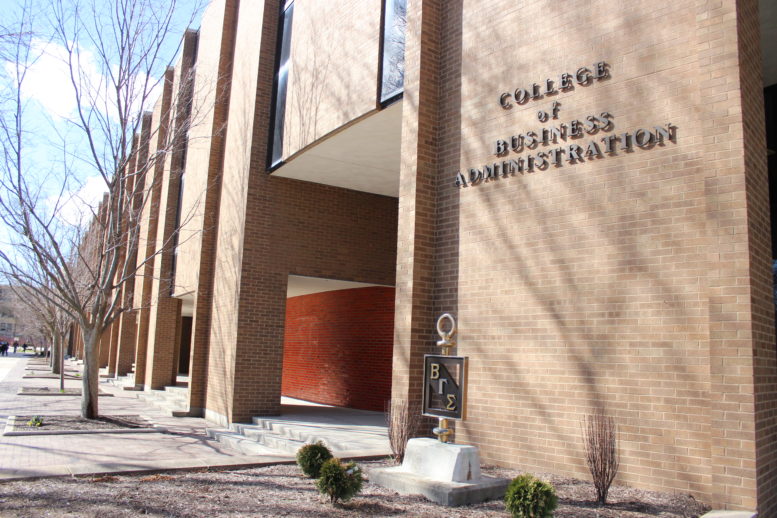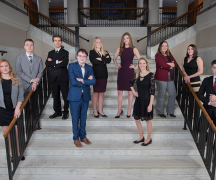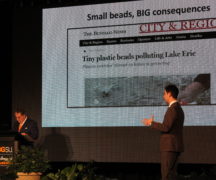By DAVID DUPONT
BG Independent News
Fledgling entrepreneurs at Bowling Green State University hatch all kinds of ideas, and every year at The Hatch they get to test how those ideas will fly with a panel of possible investors.
The fourth Hatch event, modeled on ABC’s “The Shark Tank,” will be presented April 7 from 6 to 8 p.m. in the ballroom in the Bowen-Thompson Student Union on campus. The event culminates E-Week, a week-long series devoted to entrepreneurship.
This year eight ideas, ranging from a solution to a dorm room space problem to a solution for a type of water pollution, will be among the ideas pitched by individuals and teams to a panel of BGSU graduates with money to invest.
Kirk Kern, director of the Dallas-Hamilton Center for Entrepreneurial Leadership, said that the major changes for the event are adding graduate students and students working in teams to the mix.
“What we’re trying to do is get a better quality of ideas,” he said.
Kern said the vision is to expand even further to include faculty, staff and alumni. Already, he said, graduates will approach staff at the Dallas-Hamilton Center for help developing their business ideas. “That’s a logical extension,” he said.
The event is also moving back to the ballroom after one year at the Stroh Center. Last year, Kern said, with 3,500 people attending, the event seemed too overwhelming.
The focus is on the business ideas. The eight pitches were culled from 130 applications. Those students selected are then paired up with business mentors who help them refine their ideas.
For Khory Katz, a sophomore studying finance in the College of Business Administration, that meant a trip over spring break to Cleveland. Katz is working with fellow finance major Meredith Moore on a no-hassle loft bed. The idea is to make it easier to adjust the height of a dorm loft bed to give students more space flexibility in their rooms. As it stands now, Katz said, the bed gets set at the beginning of the semester and that’s where it stays.
In Cleveland, he visited Balance, Inc., a company that supports product innovation, to review his proposal. They provided useful insight into how to develop it and expressed interest in working further with Moore and him.
The company, Kern said, was so impressed they told him they wanted to be involved in the program in the proof of concepts stage.
The Hatch was the reason Katz wanted to enroll at BGSU. He attended while he was in high school when a graduate of his high school participated. “I wanted to be on that stage,” he said.
For Giuseppi Giammanco, the first graduate student to participate, the event is broadening his horizons. Giammanco discussed The Hatch at February’s university Board of Trustees meeting.
Giammanco does research in the Center for Photochemical Science. As part of his studies he has developed a product to replace polyethylene beads in cosmetic products. Manufacturers are facing a federal deadline to get those microscopic plastic beads out of their products because they pollute Lake Erie and other waterways.
Giammanco has developed a product he’s tentatively calling BG Beads, sugar-based biodegradable microbeads that are 100-percent petroleum free with no toxic chemicals. He believes they would serve as a good alternative to plastic particle microbeads in cosmetics, he told the trustees.
At first he wasn’t sure he would be able to fit the Hatch into his graduate work, but his advisor Alexis Ostrowski encouraged him to apply.
Giammanco said: “It’s been great to have the opportunity to translate my research to a real life case, to solve problems. … It’s materializing my knowledge into something that can be useful. What I’m learning from The Hatch is that doing business is not just about the money. It’s about having the opportunity to change the world for good. They’re opening my eyes. I’m thinking of lot of possibilities for me. I had no intentions to do something different than chemistry last year. Now I’m thinking on a lot of possibilities for me.”
At the trustees meeting Ray Braun, the dean of the College of Business Administration, said that the changes to The Hatch are part of a continual fine tuning of the university’s entrepreneurship program.
The university offers a five-course minor in entrepreneurship open to students in all majors. In the past those five courses had to be taken in a strict order. That meant too few students were actually completing the minor, compared to the 200 who took the introductory course. They’ve changed the sequencing, Braun said, so that last year 300 students took the introductory course and 36 graduated in May with minors. He said he expects the number of graduates to increase.
The program has also started programs specifically for visual artists and musicians, Braun said, “to help artistic students market and earn a living for their skills.”





